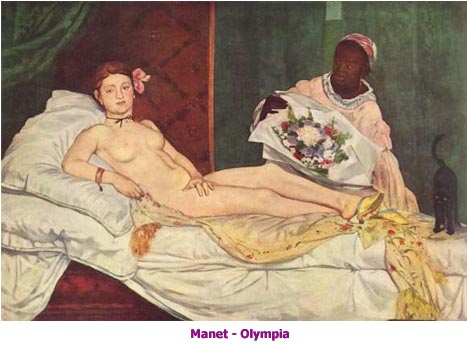
The Musee
d'Orsay
1, rue de Solférino. Metro
:
Solférino. 10am - 6pm.
Thursday : 10am - 9h45pm
 The
heavy-set, stone Musee d'Orsay, in a
converted railway station, located on the riverfront, contains three
floors of painting and sculpture from 1848 to 1914, including the
electrifying Impressionists and their successors, the
Post-Impressionists.
The building itself was originally inaugurated as
a
railway station in 1900, continuing to serve the stations of the
southest France until 1939. After that, the theatre troupe
Renauld-Barrault staged several production here, Orson Welles filmed
his version of kafka's the Trial here and De Gaulle used it to announce
his coup d'etat of may 19, 1958. Notwithstanding this illustrious
history, it was only spared a hotel developer's bulldozer by a colossal
wave of public indignation and remorse on the part of the city
authorities at the destruction of les halles.
The job of redesigning the interior as a museum
was
given, in 1986, to fashionable Milanese architect Gae Aulenti. The
results are, without doubt, ingenious, a combination of well-laid out
galleries, ample ligthning, fine presentation and invigorating pulse
reminiscent of its days as a train station. Critics complain that
the space is overdesigned and the collection overwhelmingly large, but
don't be put off : the collection is unsurpassed in quality, as well as
quantity. It's well worth taking hald a day, if not a whole one, to
meander through it.
The collection is arranged in a cavernous central
space and on three storeys either side. The general layout follows a
loose chronological thread, beginning in the ground floor, continuing
on the top floor and finishing on the middle level. Each room is
numbered, a fact generally ignored by most visitors, and seeing them in
order is highly advisable.
Romantic and Neoclassical artists are exhibited
on the ground floor, including, in the central aisle, the
mid-nineteenth Century sculptors Carpeaux, whose titillating
piece The Dance (1863-1869) shocked contemporary audiences, and Barye,
whose bronze cast of the seated Lion (1847) was more warmly received.
The galleries in the far left corner of the building display furniture
and architectural models, spanning Viollet-le-duc to Frank Lloyd
Wright, and ground floor features models and drawings of the Opera
Garnier, completed in 1875.
To the right of the centrale aisle, rooms
dedicated
to Ingres and Delacroix highlight the colourful and dramatically
emotional Romanticism of the early nineteenth century. Puvis de
Chavannes, Gustave Moreau and early Degas follow, while over in the
galleries to the left. Daumier, Corot, Millet and the Realist School
depart from the academic parameters of moralistic subject matter and
idealization of the past.
Enter the ground-breaking works that were to
inspire
the early Impressionists : among these are Courbet's Origin of the
World, a painting of a foresthortened nude female lounging on a
rumpled bed, her genitalia exposed, and Manet's Olympia, as a
controversial in its day for its colour contrasts and sensual surfaces,
as for the portrayal of Olympia as a defiant high-class whore. Both
paintings mark a transition from the traditional subtle
treatment of the artist's nude to the representation of explicit
sexuality.
The collection continues chronogically on the
top level. The private collection donated by the assiduous
collector and art historian Moreau-Nélaton resides in room 29
and features some of the most famous Impressionist images - Monet's
poppies (1873) and Manet's Dejeuner sur l'herbe; literally "lunch of
the grass", which was refused by the Salon in 1863. The critics
were scandalized by the alleged indecency of two fully dressed men
sitting alongside a naked female bather. The next few rooms serve up
Impressionism's most indentifiable masterpieces. Degas' ballet dancers,
caught backstages and arranged in Japanese influenced compositions,
and numerous landscapes and outdoor scenes by Renoir, Sisley, Pissaro
and Monet. The Cradle (1872) by Berthe Morisot, the only woman in the
group of early impressionists, synthetizes the classic techniques of
the movement with complex human emotion. Shimmering light and
wide brush strokes dominicate Renoir's depiction of Dancing at the
Moulin de la Galette (1876), a favourite Sunday afternoon social event
on the Butte Montmartre.
The museum owns five ot the thirty pintings in
Monet's Rouen cathedral series (1892-1894), a collection that tracks
his obsession with light. Both La Gare Saint-Lazare (1877) and Water
lilies are parts of separate series, done fifteen years beofre and
after respectively, with a similar goal in mind. Room 35, full of the
bold colours and disturbing rhythms of Van Gogh, illustrates the
Post-Impressionists' distincts departure from the already established
Impressionists. Cezanne is wonderfully represented in Room 36, his
complex Still Life with Apples and Oranges (1895), with its jaunty
diagonal lines, prefigures Cubism.
The rest of the top level is given over the
various
descendants of Impressionists. Among a number of Pointilliste works by
Seurat, Signac and others, is Rousseau's dream like Snake Charmer
(1907), made all more remarkable when you remember that the artist was
essentially self-taught. There's Gauguin, post and pre Tahiti, as well
as plenty of Toulouse Lautrec 's images of life in Paris's brassy
theatres, cafes, bars, brothels and nights clubs.
The middle level takes in Rodin and other late
nineteenth century sculptors, several rooms of superb Art Nouveau and
Jugendstil furnitures and objets, and the original somptuous reception
room of the station hotel. Overlooking the Seine, room 60 features
Klimt's Rose bushes under Trees (1905), with its glittery leaves, and
some of Munch's lesser known works. Across the corridor, tucked away in
Room 71 and 72, are the Nabis painters, Vuillard and Bonnard, whose
pieces are very much inspired by the art of Japan.
The
heavy-set, stone Musee d'Orsay, in a
converted railway station, located on the riverfront, contains three
floors of painting and sculpture from 1848 to 1914, including the
electrifying Impressionists and their successors, the
Post-Impressionists.
The building itself was originally inaugurated as
a
railway station in 1900, continuing to serve the stations of the
southest France until 1939. After that, the theatre troupe
Renauld-Barrault staged several production here, Orson Welles filmed
his version of kafka's the Trial here and De Gaulle used it to announce
his coup d'etat of may 19, 1958. Notwithstanding this illustrious
history, it was only spared a hotel developer's bulldozer by a colossal
wave of public indignation and remorse on the part of the city
authorities at the destruction of les halles.
The job of redesigning the interior as a museum
was
given, in 1986, to fashionable Milanese architect Gae Aulenti. The
results are, without doubt, ingenious, a combination of well-laid out
galleries, ample ligthning, fine presentation and invigorating pulse
reminiscent of its days as a train station. Critics complain that
the space is overdesigned and the collection overwhelmingly large, but
don't be put off : the collection is unsurpassed in quality, as well as
quantity. It's well worth taking hald a day, if not a whole one, to
meander through it.
The collection is arranged in a cavernous central
space and on three storeys either side. The general layout follows a
loose chronological thread, beginning in the ground floor, continuing
on the top floor and finishing on the middle level. Each room is
numbered, a fact generally ignored by most visitors, and seeing them in
order is highly advisable.
Romantic and Neoclassical artists are exhibited
on the ground floor, including, in the central aisle, the
mid-nineteenth Century sculptors Carpeaux, whose titillating
piece The Dance (1863-1869) shocked contemporary audiences, and Barye,
whose bronze cast of the seated Lion (1847) was more warmly received.
The galleries in the far left corner of the building display furniture
and architectural models, spanning Viollet-le-duc to Frank Lloyd
Wright, and ground floor features models and drawings of the Opera
Garnier, completed in 1875.
To the right of the centrale aisle, rooms
dedicated
to Ingres and Delacroix highlight the colourful and dramatically
emotional Romanticism of the early nineteenth century. Puvis de
Chavannes, Gustave Moreau and early Degas follow, while over in the
galleries to the left. Daumier, Corot, Millet and the Realist School
depart from the academic parameters of moralistic subject matter and
idealization of the past.
Enter the ground-breaking works that were to
inspire
the early Impressionists : among these are Courbet's Origin of the
World, a painting of a foresthortened nude female lounging on a
rumpled bed, her genitalia exposed, and Manet's Olympia, as a
controversial in its day for its colour contrasts and sensual surfaces,
as for the portrayal of Olympia as a defiant high-class whore. Both
paintings mark a transition from the traditional subtle
treatment of the artist's nude to the representation of explicit
sexuality.
The collection continues chronogically on the
top level. The private collection donated by the assiduous
collector and art historian Moreau-Nélaton resides in room 29
and features some of the most famous Impressionist images - Monet's
poppies (1873) and Manet's Dejeuner sur l'herbe; literally "lunch of
the grass", which was refused by the Salon in 1863. The critics
were scandalized by the alleged indecency of two fully dressed men
sitting alongside a naked female bather. The next few rooms serve up
Impressionism's most indentifiable masterpieces. Degas' ballet dancers,
caught backstages and arranged in Japanese influenced compositions,
and numerous landscapes and outdoor scenes by Renoir, Sisley, Pissaro
and Monet. The Cradle (1872) by Berthe Morisot, the only woman in the
group of early impressionists, synthetizes the classic techniques of
the movement with complex human emotion. Shimmering light and
wide brush strokes dominicate Renoir's depiction of Dancing at the
Moulin de la Galette (1876), a favourite Sunday afternoon social event
on the Butte Montmartre.
The museum owns five ot the thirty pintings in
Monet's Rouen cathedral series (1892-1894), a collection that tracks
his obsession with light. Both La Gare Saint-Lazare (1877) and Water
lilies are parts of separate series, done fifteen years beofre and
after respectively, with a similar goal in mind. Room 35, full of the
bold colours and disturbing rhythms of Van Gogh, illustrates the
Post-Impressionists' distincts departure from the already established
Impressionists. Cezanne is wonderfully represented in Room 36, his
complex Still Life with Apples and Oranges (1895), with its jaunty
diagonal lines, prefigures Cubism.
The rest of the top level is given over the
various
descendants of Impressionists. Among a number of Pointilliste works by
Seurat, Signac and others, is Rousseau's dream like Snake Charmer
(1907), made all more remarkable when you remember that the artist was
essentially self-taught. There's Gauguin, post and pre Tahiti, as well
as plenty of Toulouse Lautrec 's images of life in Paris's brassy
theatres, cafes, bars, brothels and nights clubs.
The middle level takes in Rodin and other late
nineteenth century sculptors, several rooms of superb Art Nouveau and
Jugendstil furnitures and objets, and the original somptuous reception
room of the station hotel. Overlooking the Seine, room 60 features
Klimt's Rose bushes under Trees (1905), with its glittery leaves, and
some of Munch's lesser known works. Across the corridor, tucked away in
Room 71 and 72, are the Nabis painters, Vuillard and Bonnard, whose
pieces are very much inspired by the art of Japan.








30 mn walking from Studio
Marais , rue du Bourg-Tibourg or
Studio
Sicile , rue du Roi de Sicile.

 The
heavy-set, stone Musee d'Orsay, in a
converted railway station, located on the riverfront, contains three
floors of painting and sculpture from 1848 to 1914, including the
electrifying Impressionists and their successors, the
Post-Impressionists.
The
heavy-set, stone Musee d'Orsay, in a
converted railway station, located on the riverfront, contains three
floors of painting and sculpture from 1848 to 1914, including the
electrifying Impressionists and their successors, the
Post-Impressionists.






